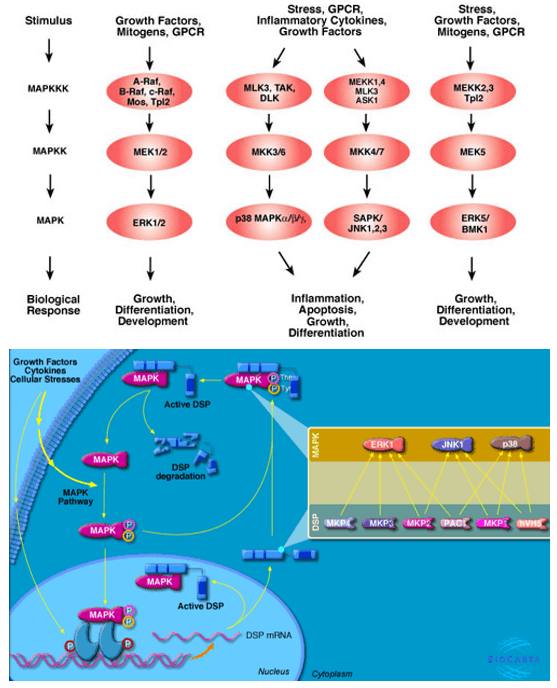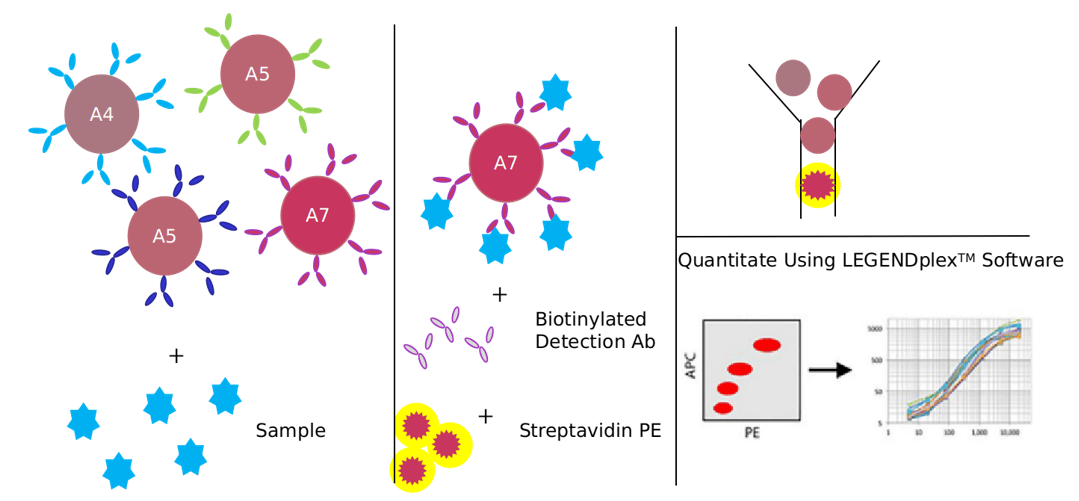MAPK cell signaling pathway
Based on Luminex technology platform, Creative Proteomics provides analysis services for key targets of MAPK cell signaling pathway.
Mitogen-activated protein kinase (MAPK) signal transduction system, as a classical cell signal transduction pathway, is an important way to regulate the cell cycle. The activation of MAPK is a phosphorylation cascade reaction initiated by various signal molecules. Signal transduction plays an important role in the occurrence and development of gastric cancer.
MAPKs are a class of highly conserved oncogene products, belonging to a large family of serine/threonine kinases, which constitute the main cell proliferation signal from the cell membrane to the nucleus, and are closely related to cell proliferation, differentiation, and apoptosis. MAPK is composed of extracellu larsignal regulated kinases (ERK MAPKs, Ras/Raf/MEK/ERK), C-Jun-N terminal kinases/stress activated protein kinases (thee-Jun Nterminal kinases/stress activated protein kinases, JNK MAPKs/SAPMAPKs3 and p38MAPK consist of three main sub-families. It is currently known that these cascades can change the expression of tumor-related genes. The ERKMAPK pathway is the most important signal transduction pathway for cell proliferation.
MAPK signal transduction pathway is an important signal system that mediates cellular responses. The MAPK cascade is very complex. These pathways can be activated by different extracellular signals, and then specific extracellular stimulation signals induce protein kinase tyrosine phosphate. The conversion is converted to protein kinase serine/threonine phosphorylation, which allows the signal to be transduced downstream. Therefore it is located at the convergence point of many cytokine signal transduction pathways.

MAPK signal transduction pathway plays an important role in the occurrence and development of gastric cancer. The detection of the components of the MAPK signal pathway can help predict the survival rate and prognosis of gastric cancer. MAPK inhibitors can interfere with the MAPK signal transduction pathway to inhibit the growth of gastric cancer cells. Proliferate, promote the apoptosis of gastric cancer cells, and reduce the invasiveness of gastric cancer cells.
Our detectable targets:
| A-Raf | B-Raf | c-Raf | MLK3 | TAK | DLK |
| MEKK1 | MEKK4 | ASK1 | MEKK2 | MEKK3 | TPI2 |
| MEK1 | MEK2 | MKK3 | MKK6 | MKK4 | MKK7 |
| MEK5 | ERK1 | ERK2 | p38 | JNK1 | JNK3 |
| JNK2 | ERK5 | BMK1 | SAPK | MKP1 | MKP2 |
| MKP3 | MKP4 | hVH5 | MAPK |
Technology platform
We provide Luminex technology for MAPK signaling pathway analysis.
Luminex technology is a multifunctional liquid phase analysis platform developed on the basis of colored microspheres, laser technology, applied fluidics and high-speed digital signal processing technology. The core is to encode polypropylene microspheres or magnetic microspheres with fluorescent dyes. By adjusting the different ratios of the two fluorescent dyes, up to 100 microspheres with different fluorescence spectra can be obtained. Each kind of microspheres is covalently cross-linked. Capture antibodies against specific antigens.
MAPK signal transduction pathway plays an important role in the occurrence and development of gastric cancer. It is widely used to inhibit the proliferation of gastric cancer cells, promote the apoptosis of gastric cancer cells and reduce the invasiveness of gastric cancer cells.
In addition to Luminex Multiplex Assay, Enzyme-linked immunosorbent assay (ELISA), Flow cytometry (FACS analysis) technology can also be provided to meet other customer needs.
Advantages of MAPK signaling pathway detection:
- Versatility: VEGF signaling pathway technology can be applied to a variety of biological tests, including immune analysis, genotyping, gene expression, enzyme analysis, etc. It can detect both protein and nucleic acid. In addition to clinical use, it can also be used in scientific research, CDC, blood stations, agricultural, biological and pharmaceutical professional laboratories.
- Good repeatability: similar homogeneous reaction mode, each indicator has 1000-5000 reaction units, and the median value of 100 analysis is taken.

Application of our service:
- To study the regulation mechanism of MAPK cell signal pathway in disease
- To study the effect of each virus on MAPK cell signaling pathway
- To study the effects of drugs or therapies on MAPK cell signaling pathways
Creative Proteomics has developed a signal pathway target detection platform. We are not limited to providing MAPK cell signal path detection services, but can also provide other signal path detection services. If you want to detect other targets, please contact us and we will customize the service for you. Look forward to working with you.
References:
- Shin BA, Yoo HG, et al. P38 MAPK pathway is involved in the urokinase plasminogen activator expression in human gastric SNU-638 cells. Oncol Rep, 2020, 10: 1467-1471.
- Fu G, Wang GB, et al. MAPK singal transduction and apoptosis of human gastric carcinoma cells induced by liposomes of survivin antisense oligonucleotide. World Chin J Digestol. 2004, 12: 1034-1039.



